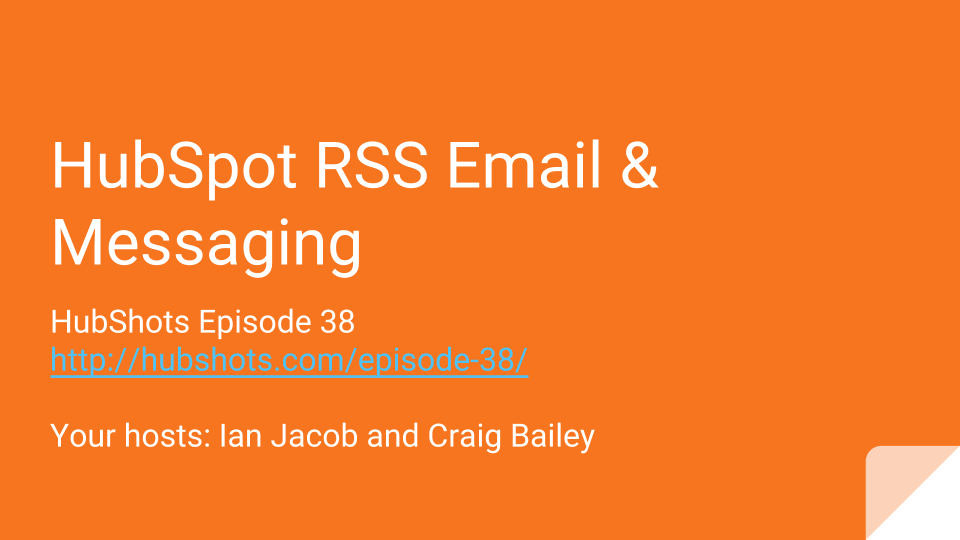Episode 39: HubSpot Email Reporting Tip, Attribution Marketing, Voice Search
Welcome to Episode 39 of HubShots! Recorded: Tuesday 21 June 2016 This week we’re again testing adding the show notes in a range of formats including
Recorded: Wednesday 15 June 2016
This week we're testing adding the show notes in a range of formats. You can view the Google slides on Slideshare below:
Or watch the show as a screencast:
Or read through the transcript along with the links and slides:
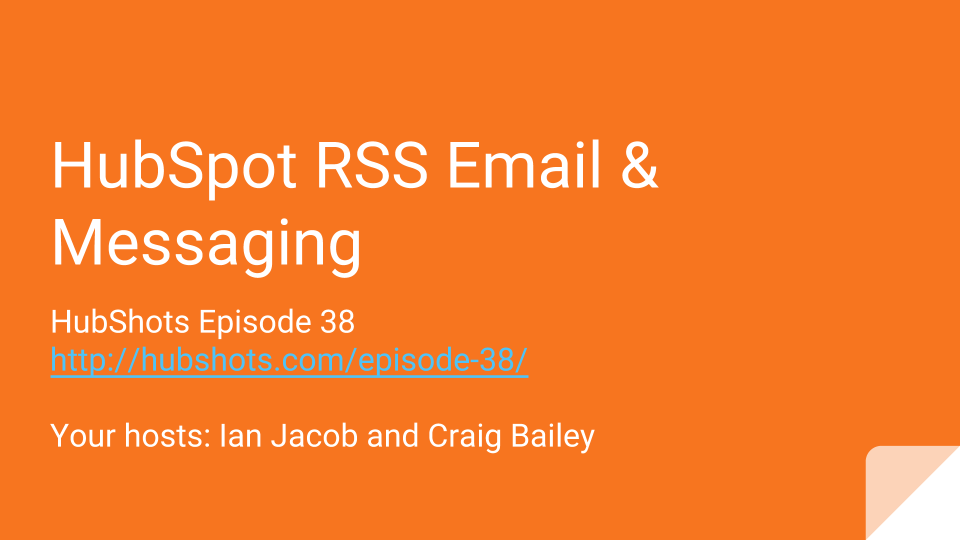
Ian: Hi, everyone. Welcome to HubShots, episode 38. I'm joined by my cohost, Craig Bailey from XEN Systems, and I'm Ian Jacob from Search & Be Found. How are you, Craig?
Craig: I'm well, Ian. Good to be here for another episode.
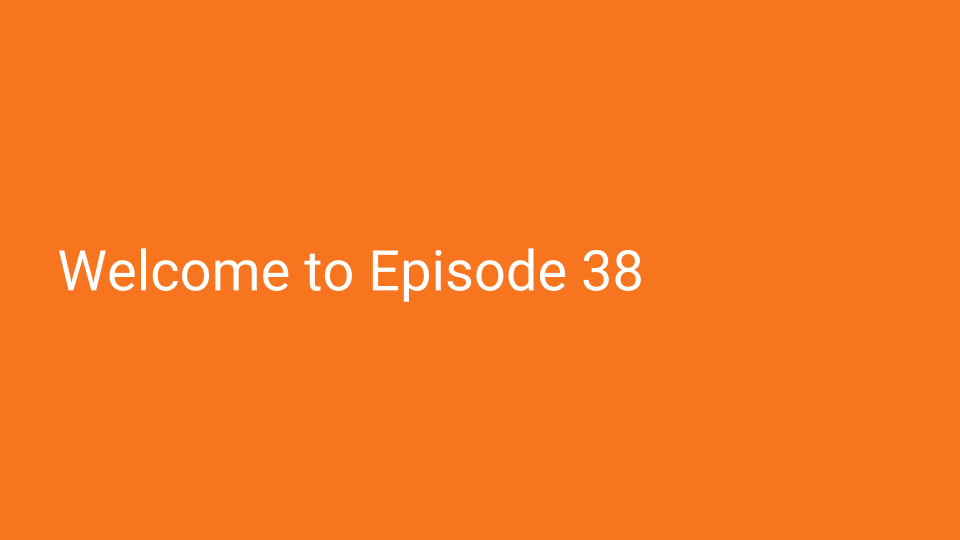
Ian: And now let me tell you what HubShots is all about. It is a podcast for marketing managers that are either using HubSpot or considering using HubSpot. So if you fit into that, listen on. Now onto shot one, Craig.
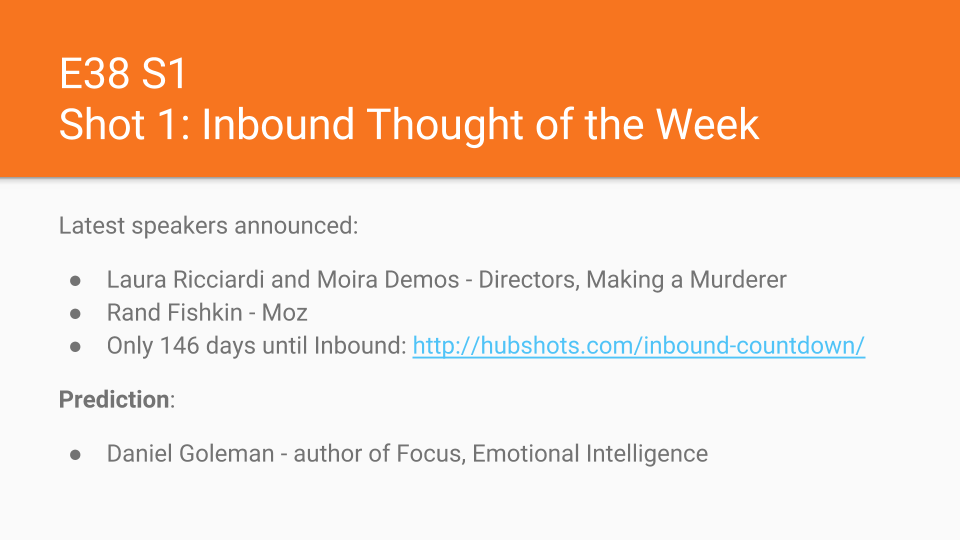
Craig: Our Inbound thought of the week. By the way, only 146 days to INBOUND. So it's getting closer.
Ian: I know. It's getting closer by the day. We've got under the 200 mark, now we're getting close to the 100, and before you know it, we'll be in Boston.
Craig: Sneaks up on you. And two more sets of speakers announced, as well.
Ian: Yes. We have Laura Ricciardi, and Moira Demos. Now they're directors of Making a Murderer, which is a Netflix series.
Craig: Yeah, Making a Murderer was a huge phenomenon really. I actually haven't seen it.
Ian: Neither have I. But I'm going to go watch it now.
Craig: I don't know if I will, because I actually heard that the ending is a bit infuriating, just the way it unfolds. But what's interesting about it is that it's a story. It's an example of telling a story. And I was looking at the blog post announcement, and was going, "I wonder why they've invited these two to speak?" Similar like to my reaction to Alec Baldwin, "What's he doing there?" kind of thing. But it's on point, because it's about storytelling. They're experts at it. They've had a huge audience following as a result, and I'm sure they've got a number of useful points to share about how to tell a story.
Ian: That's right, and I think people are looking to connect with stories, right? That's how we get our message across, and we share our experiences and our stories as we do that, and that's what people are connecting with. So I think it's cool.
Craig: Yeah, that will be good. And another favourite, the...
Ian: The Wizard of Moz? Rand.
Craig: Rand will be there. He's great. So founder of Moz, big influencer in the SEO and in the marketing space.
Ian: And did you know he was the founder of INBOUND at all? A cofounder?
Craig: Right, yeah. That's right. He and Dharmesh got together and look at the baby they have produced. Yeah.
Ian: Yeah, fantastic. So I'm really looking forward to seeing him. I know he's been on the speaking circuit this year.
Craig: He's a good speaker.
Ian: He is.
Craig: It's always good to see him. Well, I'll give you another one of my predictions.
Ian: Yeah, I would love to hear one of your predictions.
Craig: Also known as who I'd like to see as a speaker. So, Daniel Goleman. I've been reading one of his books, "Focus" So have you heard of Daniel Goleman? He wrote that book many years ago called "Emotional Intelligence."
Ian: Yes.
Craig: It was very widely read and received, and he's written one more recently in the last couple of years, called "Focus" that I'm reading through.
Ian: And I've been loving your excerpts on that book through Snapchat.
Craig: I have been sharing a few shots on Snapchat. Yeah, so he's really good. He looks at the way that people learn and absorb information, and how they can be focused on a task. You know, that's one of my kind of interests at the moment, how to increase productivity in that, so he's very well read on the whole topic, and he would have a lot to say, so that's who I'd love to see.
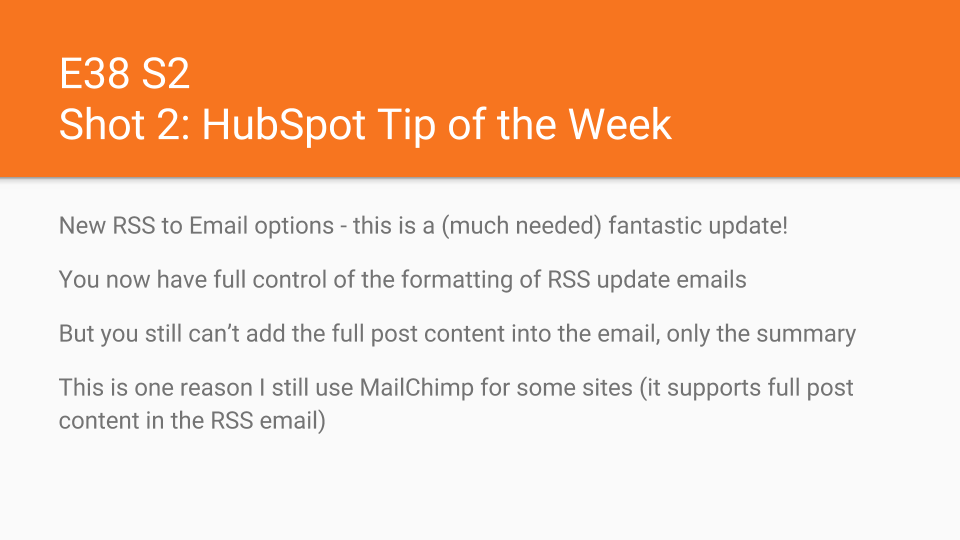
Ian: Excellent. Now onto shot two, which is our HubSpot tip of the week. And this is something that we've just seen, it's new RSS to email options. Now, this is a pretty big. I think it kind of slightly slid under the radar, but it's actually a pretty impressive up there, right?
Craig: Yeah, they should be shouting about this one, because it's a much needed, I will say, but it's a fantastic update. So this is their RSS to email formatting options in the RSS emails that you send from HubSpot. Now for the longest time, they've not been editable in terms of the formatting, so just things like font sizes, colours, all that kind of thing that get included, you had no control over that, which I found extremely frustrating. I know a lot of people did.
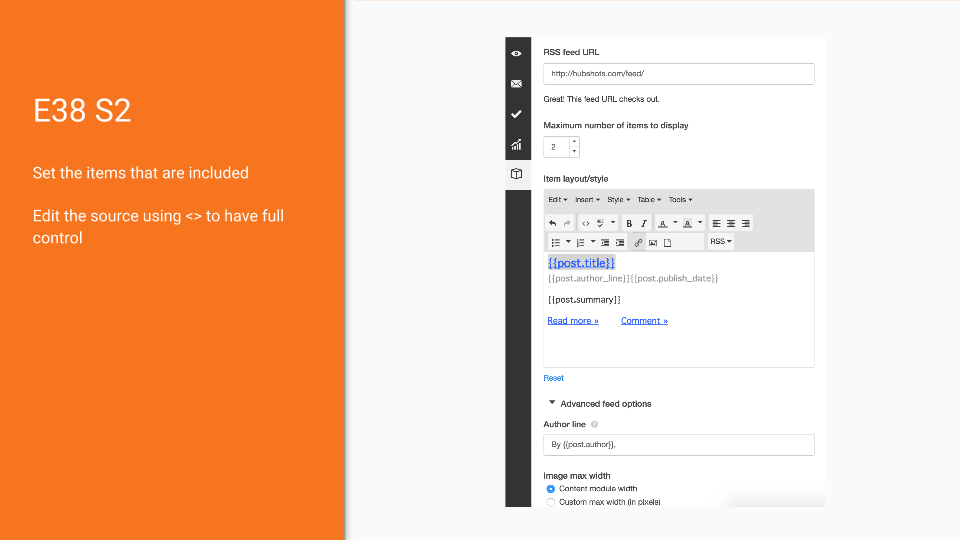
Ian: Now, Craig, I'm going to take it one step back. What is RSS?
Craig: Oh good point, yes.
Ian: Now, I'm going to explain it. It's actually a Rich Site Summary. So it's often used for syndication. So that's to spread, or people can subscribe to your feed, and they get information, whenever your information's published, they'll get notified and it will appear in their feeds to they can read it. Just another way to get to your audience, right? A lot of people probably don't use it, or probably unknowingly using, but it's this, so it's really important. It's a channel that I think you need to look on your website and your blog, and make sure that it's actually configured correctly, now you get to format it correctly. So I think it's a big thing.
Craig: Yeah, well RSS, I think it's used more often than you might expect. So any of the apps like Feedly that we've looked at before, and any of those tools that can read blog feeds, they'll look for the RSS feed, and so one of the common ways that we take that feed and share it with our audience, is we might import it into an email that automatically gets sent out. So HubSpot's actually had that feature for a long time, but what they've added now is actually the ability to format the way that the email looks. So it pulls in your feed, so in that we've got some screenshots that will show how that's pulled in, for example, the HubShot's feed itself from WordPress pulls that feed in. And then you can see how it's actually formatted now, so you can control the way that appears in your emails.
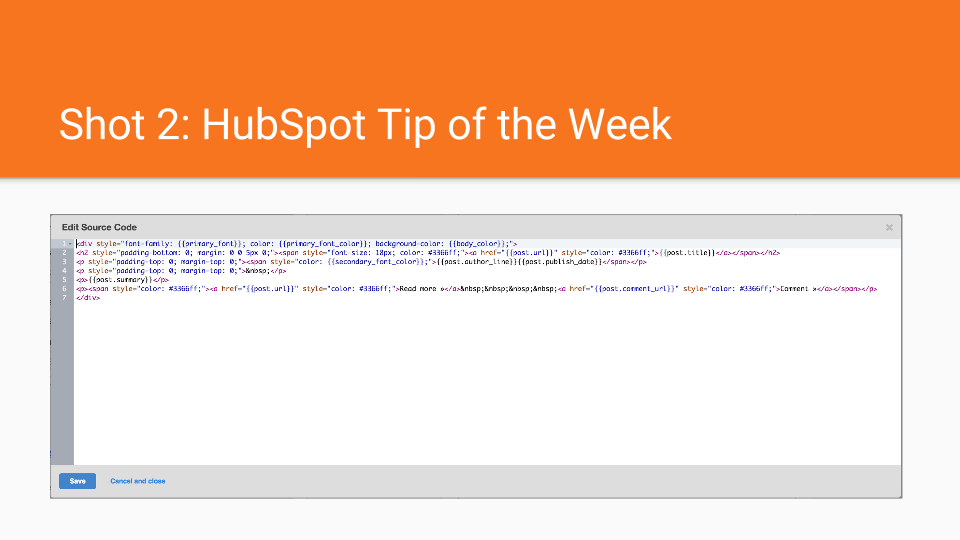
Now this has been, I guess, much needed, and so it's really good to see. Like this is actually a big product improvement, so I'm really glad to see this. I will say, however, it's still limited. So one of the things that I'm a little bit disappointed is that you can still only pull a summary from the feed. You can't actually include the full post in an email that goes out, as some other tools can. So for example, I actually still use MailChimp for some sites, because it does have that feature. So I'd really love to see that in HubSpot in the future as well. But apart from that, fantastic update, and for 90% of use cases, this will be a really good improvement.
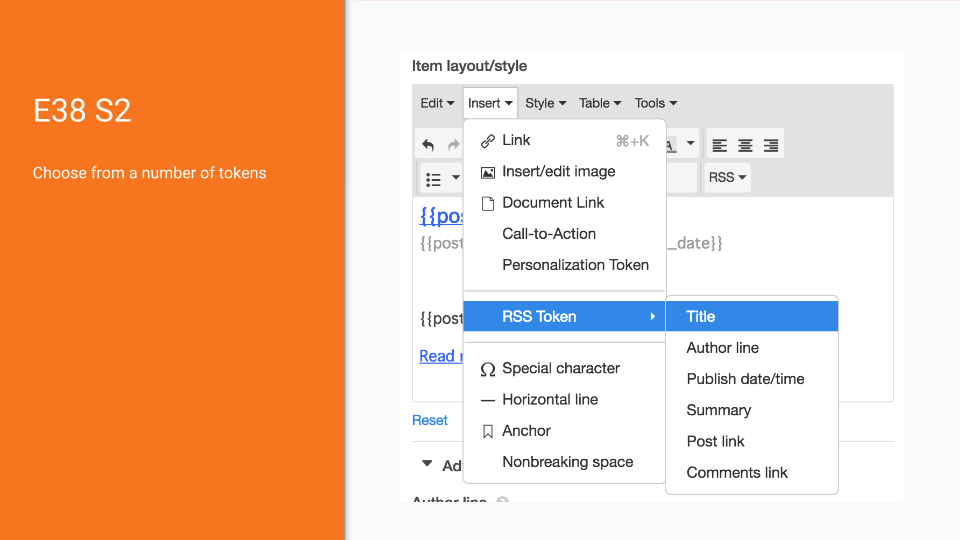
Ian: Yeah, I couldn't agree. I think take advantage of it, and go and check it out, and if you haven't actually configured it correctly, configure it correctly. All right, now onto our other tip of the week.
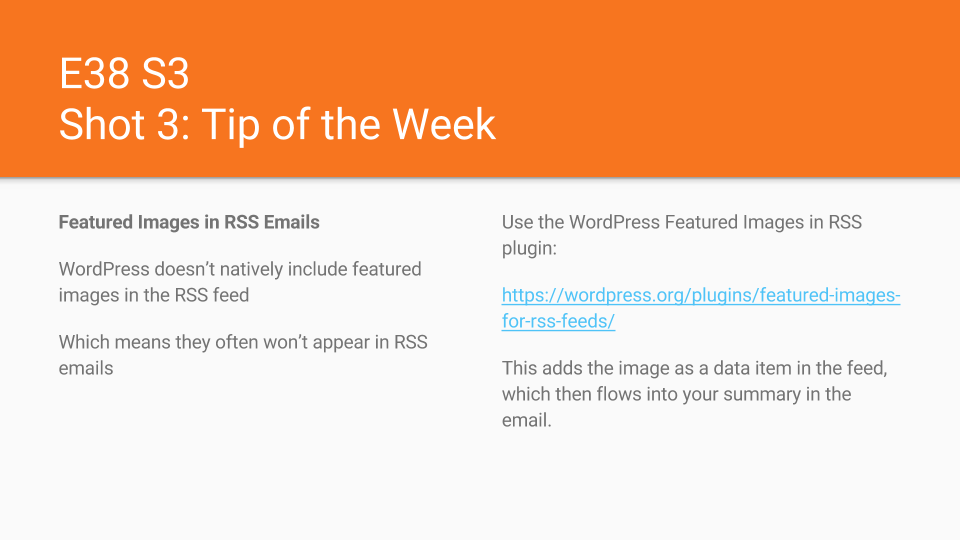
Craig: All right, so I actually just did want to throw out this, because featured images are something that we like to include in emails that go out. So this is following on from the RSS to email feature update. A lot of people have an issue where they want their featured image, so you've got a blog post on your blog and it's got a featured image at the top, and that doesn't get pulled through into your feed, so your email...
Ian: Yes, which can be very annoying.
Craig: Can be annoying. So you want that image in. And so, in WordPress, that actually isn't natively included in the feed. So this sounds a little bit technical, but if you understand what I'm saying, it's because you have this frustration. If you don't have this frustration, then you can ignore this part, but the solution is there's a WordPress plugin called Featured Images, funnily enough, in RSS emails, couldn't be more descriptive. Add that plugin, we've got that on the HubShots site, for example, and that's why our featured images go through, and they appear in those emails that get sent out from HubSpot. So a little tip there.
Ian: Excellent. That's a great tip. So that's a tip for people using HubSpot as their blog.
Craig: That's actually for WordPress as their blog.
Ian: Sorry, WordPress.
Craig: But HubSpot as their RSS email.
Ian: Correct. Yes.
Craig: Yes, that's right. Whereas I think HubSpot, if you've got the HubSpot blog, the featured image will come through automatically.
Craig: It's already there, correct.
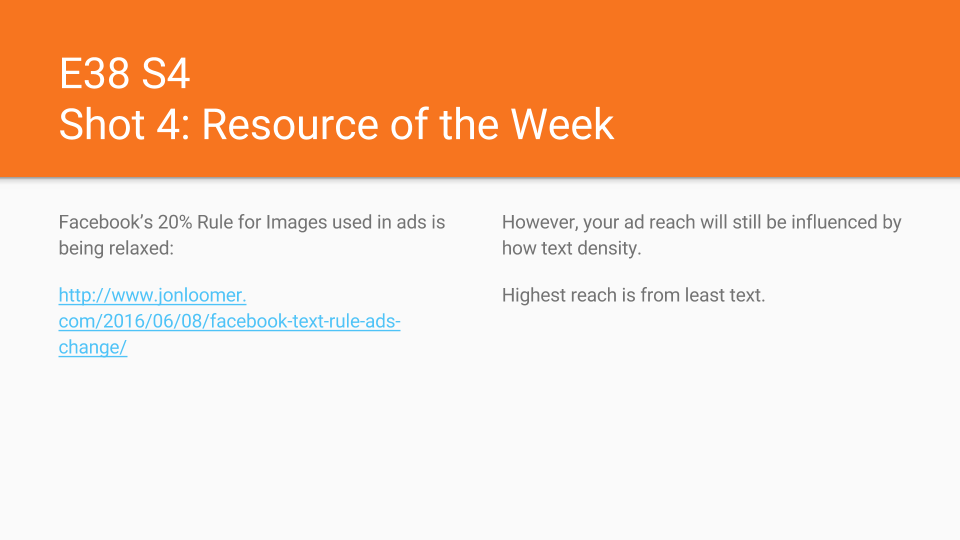
Ian: Yeah. Excellent. All right, and onto our shot four which is the resource of the week. Now this is something...we talk about Facebook all the time, Craig, and Facebook has this 20% rule on images. So we're now talking about the text image rule, and we found out that it's kind of been relaxed. Is that right?
Craig: This is right, because Facebook...just to explain the 20% rule, what they had is kind of a grid overlay, and if 20% of the grids, more than 20% of the grids had texts in them, they wouldn't approve your ad to show on the ad network. Of course, normal posts could have it, that's no problem, but if you wanted to have an ad that was promoted, for example, they would knock it back. Well, they've actually relaxed that. And now they're kind of saying the less text, the more reach you'll get. But even if it's text heavy, they'll still show it as an ad, but it just might get reduced reach.
Ian: Which is really interesting. I was having a read through that article on Jon Loomer's site, and I thought that was really interesting, like just the whole breakdown of how using this text on image to determine reach, right, just another way of skinning the cat, so to speak. I guess it's not really stopping people, just saying, "Look, if you do this, then this is what's going to happen." So again, test and measure. See what works and what doesn't work. I've had ads rejected because there was too much text on there. But again, it varies on the time of day that you submit stuff, and how you submit it, and what other ads are going with it. So just test and see what works for you. But it's a great resource, I think, for the week.
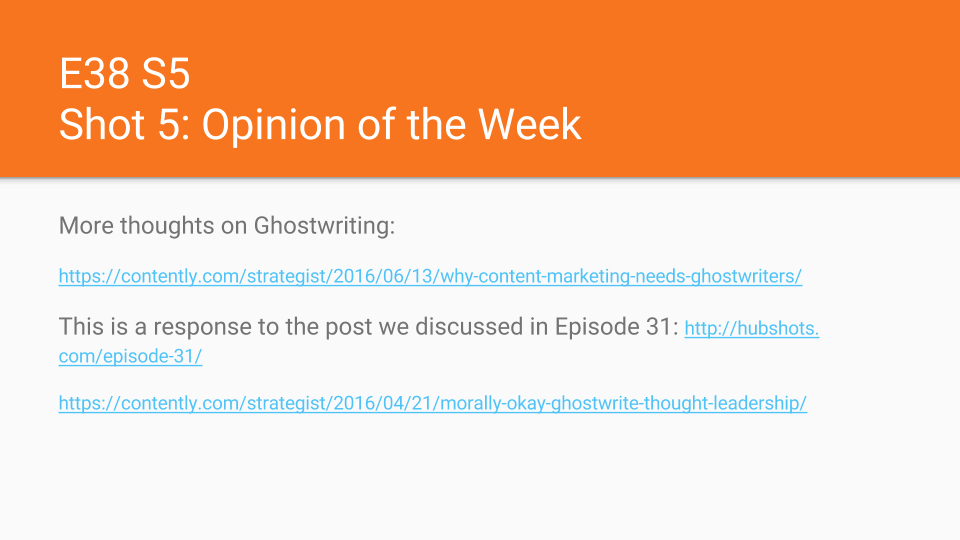
All right. Now onto the shot five, Craig, which is the opinion of the week. Now, we spoke about this a few episodes ago, and it's about ghostwriting, because as we get into this world and we're creating content, and we're connecting with people, we're creating micro moments, or we're filling these micro moments with the right content…we're looking for ways to fill it with the right content, right? And ghostwriting comes into a part of that. You know, we have people on teams that write content for other businesses, write for ourselves, some write for us sometimes. It's a very interesting topic, and we discussed this last time, but what I wanted to highlight, there's a response to that discussion, and one of those responses is in contently, right?
Craig: Yeah, that's right. So just to recap, back in episode 31, we discussed this whole topic around an original post that was on contently back at the time, saying it wasn't morally okay to ghostwrite the thought leadership. Now, it's important the distinction here. It's not just ghostwriting normal informational pieces.
Ian: Correct.
Craig: It's around thought leadership, and the writer at that time, she was specifically talking about CEOs and managers that have thought leadership written for them, so the point being that those CEOs have no input into it. It's not as though someone's just writing down the thoughts of the CEO, it's they are actually coming up with the entire piece.
Ian: The whole thing, yeah.
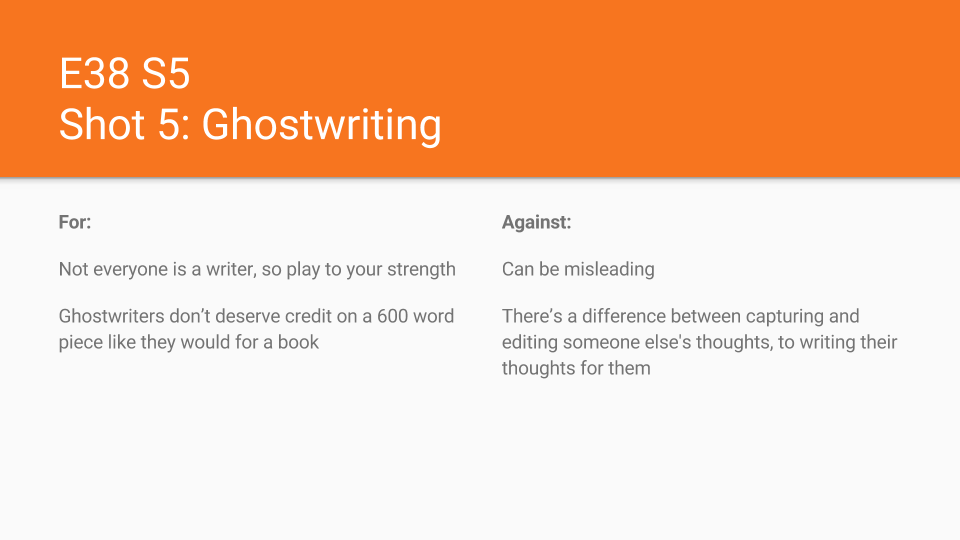
Craig: And then it's being attributed to the CEO. And so at that point, she was asking the question, "Is that actually morally okay?" And I remember when we were discussing it, I was actually leaning towards her. I was persuaded by her argument, which is I don't think it's okay, or at least the writer should get some kind of acknowledgement. However, this week there's been a response, as you said, someone saying, "Well, no, it is okay." And so they kind of put forward a few thoughts, and their kind of main thrust of their argument was, "Well, play to your strengths." So if you're a CEO, writing might not be your strength, leading and vision might be. So therefore, ghostwriting's okay.
And also, just this idea that well a ghostwriter, that's what you do. That's your job. You're writing. You don't deserve credit on a 600 word post. So I'm kind of swayed back by that argument. But however, I think the distinction is it's between capturing and editing someone's thoughts, which I think is fine, in ghostwriting. Whereas when you stretch that to actual thought leadership and actually providing all that thought leadership, I think that's a different...
Ian: It is.
Craig: I think the line is slightly crossed. So anyway, that's for listeners to decide, that's why we've put it in our opinion of the week, something to provoke thought there.
Ian: Yeah, look, I think I've told you this before, is that one of the things we do is we will interview a business leader or the person that runs a business, and then we will put together content. So we basically extract the ideas from their brain, and we take that and we formulate it, and we say, "Look, here it is. Does this sound like you?" Or, "Is this what you would write?" And that's how we get it across. So we do that quite a bit. We don't just outsource a whole lot. But I think that that works really well, because it really gets the heart of what that leader is doing, and what they're trying to achieve in a business.
Craig: Yeah, and I think that's totally fine and appropriate, and that's an effective and efficient way of capturing their thoughts, and yeah, it's a good process. So I think that's fine. And I guess in the original article, that's more what they had in mind, rather than the whole kind of outsource everything, no connection.
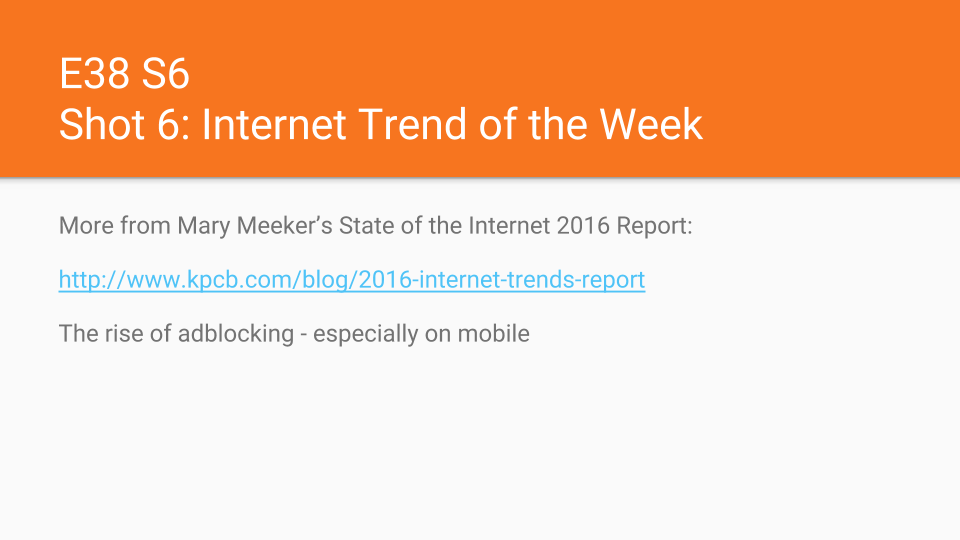
Ian: All right, now onto shot six, Craig, and this is our Internet trend of the week, and this is from Mary Meeker, State of the Internet Report for 2016. We picked a few things out last week. Now there's about 200 slides on this report, so we could be picking things off this for a long time to come, for the rest of the year. But this week, we really want to focus on two things. First one being ad blocking and the second being messaging. Now ad blocking is something that we've seen with the advent of, obviously, lots of advertising everywhere. And what's really interesting, we picked out of here how there's been such an increase, but what alarmed me from this graph that I can see is that, almost like a very exponential increase in ad blocking on mobile devices, which I was really surprised with. And you said there was a very good reason, because I don't use any ad blocking, but you do.
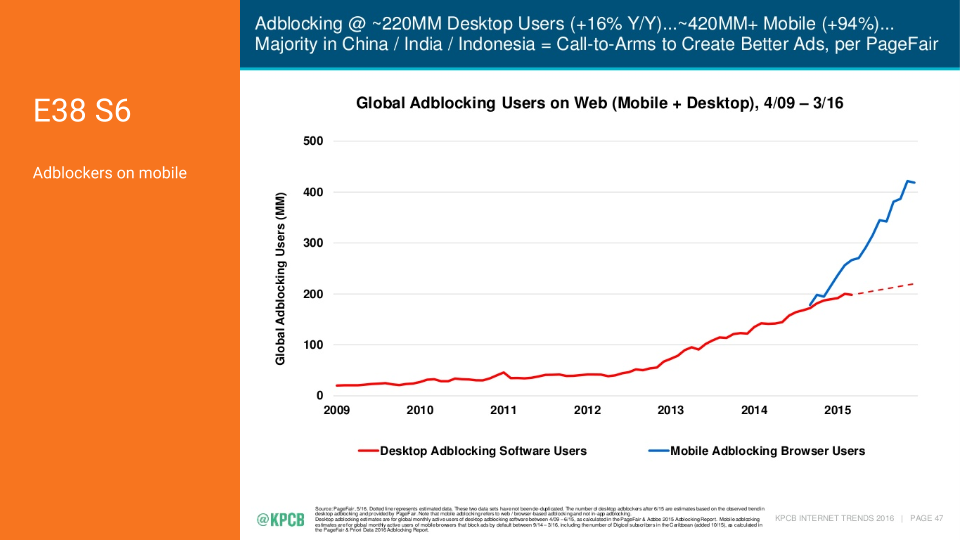
Craig: Right, you don't use ad blocking at all on your mobile?
Ian: No, and I would say that I would be probably like most people.
Craig: Okay. Isn't that funny? We think most people are like ourselves. Yeah. Well, what I will say, it's not on this particular subject that we're sharing, but I've seen other stats where it says ad blocking is much higher in Asian countries than it is in the U.S. or Australia.
Ian: Really? Okay.
Craig: So there is that distinction. So it probably isn't as high in Australia, definitely. But what this slide's actually showing is the increase in mobile over desktop. So desktop's just kind of...
Ian: On a slight increase.
Craig: On an increase, whereas mobile is really taking off. And I think one of the reasons for this, well for me, for example, when I had it, was of course in iOS 9 on the iPhone when it came out, they added ad blocking as kind of a...it was almost a feature, but promoted it. There are always ad blockers on the app store. It's very easy to do it. So I of course just added one. I've tried many of them. A lot of them were free. Why not turn it on and, you know, block ads? And I think a lot of the reason that people are doing it is not necessarily that they don't like ads, it's that they don't like the performance hit.
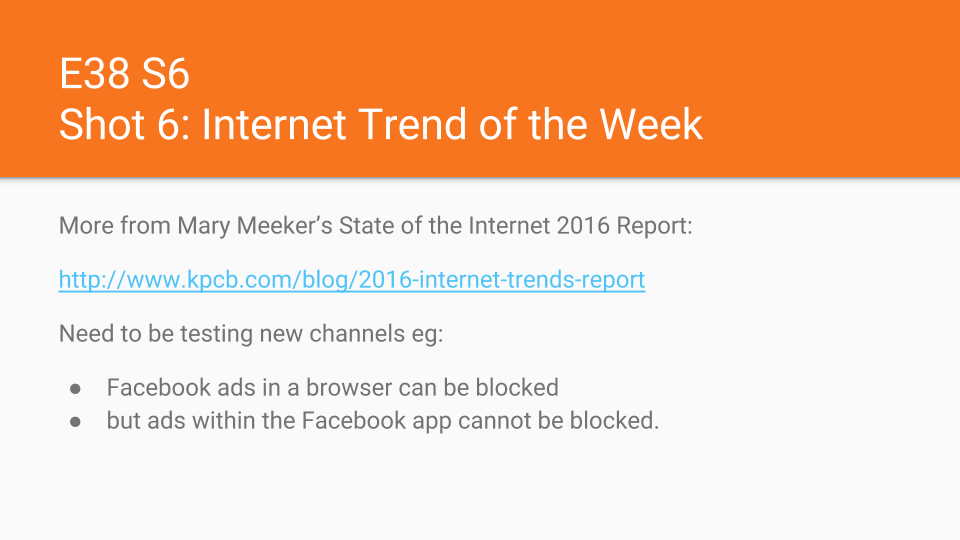
So, ads were shown to really take 10, 20 seconds, the load time of a website. So people really dislike them for that reason, as opposed to they just don't like the ad. I think people are kind of happy to see the ad if it doesn't affect other performance. But yeah, that's what we're seeing on mobile. And I guess the point about this, the reason we're raising it in the show is because if you're relying on mobile advertising, especially on Google or anything browser-based, then that is rapidly eroding. The amount of impressions that you can get is dropping down. And so you need to be looking at other channels.
Ian: Yeah, and I think what's interesting that you picked up is that ads within the Facebook app cannot be blocked, right?
Craig: That's right. Any in app experience, it's hard for an ad blocker to impact that. But if you're looking at Facebook...
Ian: On your browser.
Craig: On your browser, on your phone, then yeah, of course, you can. Not that many people would. They'd use the app. But yeah, it's really about looking at your different advertising channels, and as you said at the start of the show, we love Facebook, right? That's where we're pushing a lot of the ad budget these days, and this is another reason why it's actually gonna be more effective for you.
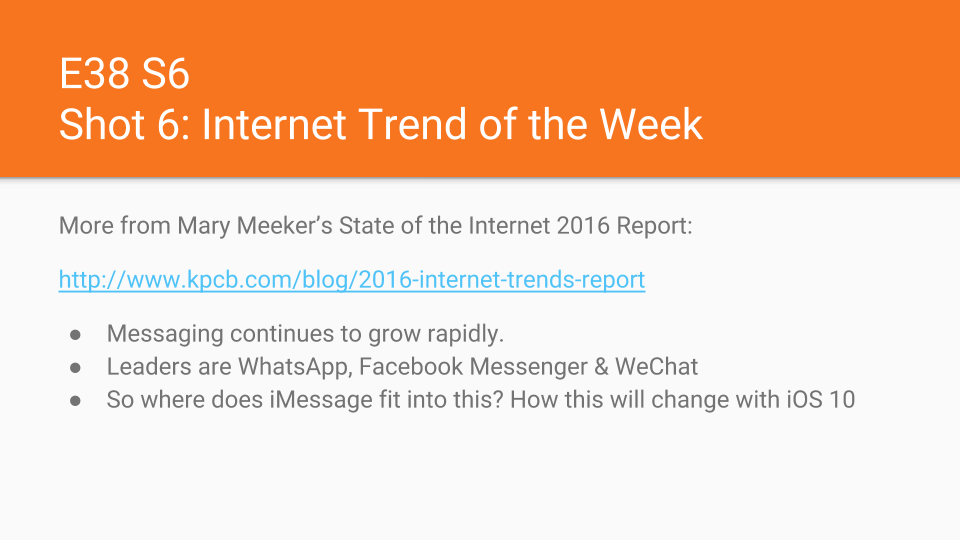
Ian: All right, and now onto the second trend, which is to do with messaging. And messaging is...I was amazed by this graph is how quickly messaging is growing. Now one of the things I picked up from there is obviously the rapid growth, but the leaders in the space being WhatsApp, Facebook Messenger, and WeChat. And that kind of surprised me a bit, because WhatsApp is actually owned by Facebook, and there's Facebook Messenger, and then there's WeChat. So WeChat's mainly used on the Chinese population, as far as I can understand. But WhatsApp and Facebook Messenger is pretty widely used amongst…
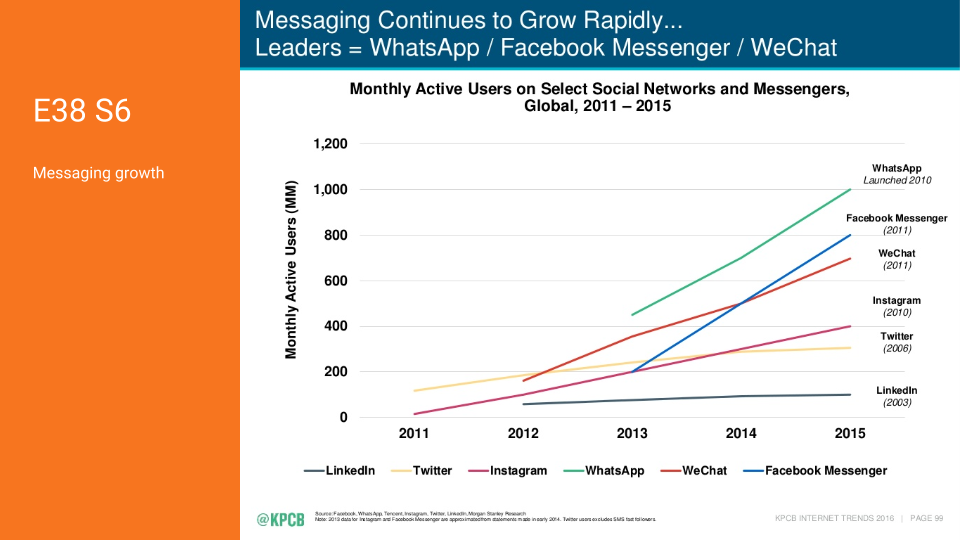
Craig: And what was after WeChat? Instagram. Another Facebook property, yes.
Ian: But what's interesting there is would you consider that a messenger application?
Craig: I know. I think it is, like that's how people interact, but yeah, I wouldn't have said it's a messaging app, although you can direct message, of course, Instagram now.
Ian: Exactly.
Craig: They did add that.
Ian: Yeah, so I think one of the things that was interesting that's not on this graph that I picked up, and I picked this up purely because I was listening to the Worldwide Developer Conference that Apple just held this week, and they were talking about the changes to iMessage, and how it's going to be an open platform so people can connect to it. They're changing the kinds of messages people can say, but, you know, machine learning about messages and how to interact about emojis and so on. So like that's just going to change everything there. But it's not featured on here for the obvious reason being Apple doesn't share those stats.
Craig: Well, they do them at the stats, but it is a stranger mission, because it must be hundreds of millions of users that are messaging with it.
Ian: That's exactly right. Just think about the number of iPhones that are sold globally, and then see what happens with messaging. I think you asked me like, "Why would you use iMessage...why would you use WhatsApp over iMessage?" And the reason is is that WhatsApp goes on many different platforms, so it works on an Android device, it works on a Windows device, it now even works on your computer, so it's a cross platform thing, whereas iMessage is obviously Apple based, so you've got to have an iPhone, an iPad, a Mac, you know, to use that.
Craig: It was interesting that one of the rumors leading into the Apple conference this week was that they might announce iMessage over on Android. I don't think they did...
Ian: No, they didn't.
Craig: There wasn't any announcement, but yeah, I guess that's the next obvious, well, opportunity for them, maybe.
Ian: Yeah.
Craig: I don't know, maybe the fact that it's Apple only is actually the differentiation in some ways. But yeah, that's right. But it's still missing, and even if it's only Apple, it still must be many hundreds of millions of users. So it should be part of the mix.
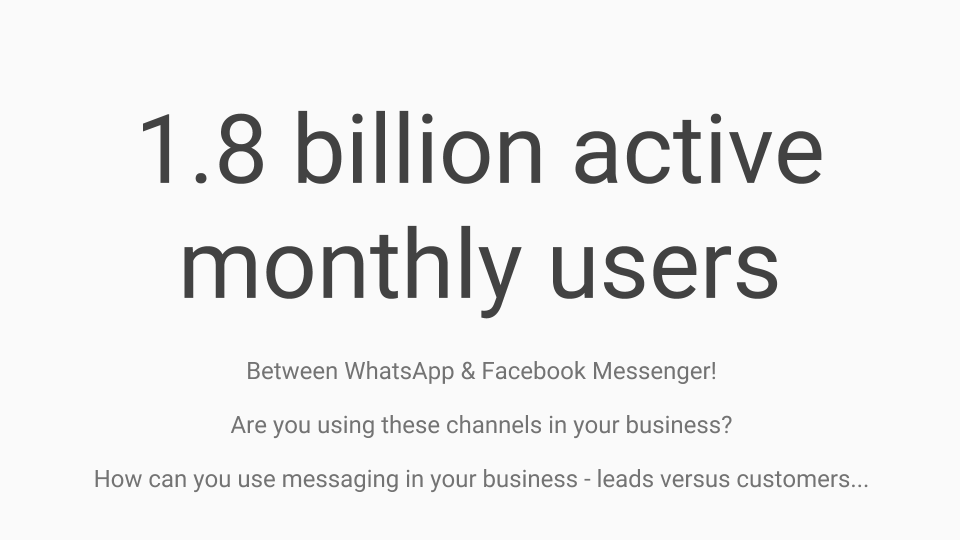
Ian: Yeah. Now I did a little addition here off that graph, and what was really interesting, on that next slide you'll see, it says on a monthly basis, right? There were 1.8 billion active users if I combine WhatsApp and Facebook Messenger. So this is Facebook owned properties, and I'm sure if I include Instagram it will be even more.
Craig: Right, but I wonder how many of them are common across…
Ian: Well, that's right. So what's interesting is the reach on these platforms and the diversity is amazing. So what I wanted to put out there was like we talked about Facebook Messenger last week and about using it that in your business, integrating it onto your website, and using it as a channel to get to people. How do you use WhatsApp in your business? Is that another channel that you could be taking...getting used to, or thinking about how can we actually communicate with customers? Or giving it as another option for people to communicate to you? Just like you give your phone number, does WhatsApp become another way that people will say, "Hey, I can contact this person on WhatsApp and start the conversation"?
Craig: It's a good question, isn't it? Because I'm struggling with this, thinking through where it actually fits in a marketing perspective, especially in B2B, and I guess where we're leaning, and we were chatting about this before the show, it's just really...I wonder if it's not so much about leads, but it's more about customers. And I think if we think back to when we were in INBOUND last year, and all the group organisation was done via WhatsApp. It was a WhatsApp share.
Ian: Yeah, and it worked really well.
Craig: Yeah, and that's because we were all, well, customers, in a sense.
Ian: Correct.
Craig: We're paid to go to the conference, and therefore we're included in the group. And I wonder if that's really where businesses should be looking at, it's more around customers rather than leads. So if you're organising an event, a user group, some kind of function for your customers, that's a way of keeping them in touch. I wonder if that's where messaging is a better fit than trying to think about it as purely an anonymous or a lead gen channel.
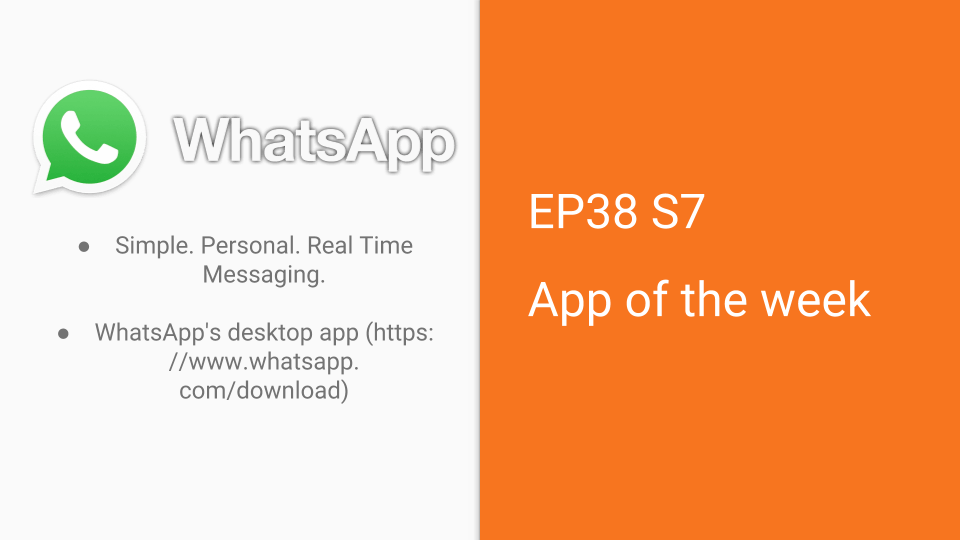
Ian: Correct. I tend to agree with that, especially with WhatsApp. In our app of the week, I chose WhatsApp for obvious reasons, and I put in there, it's really, what do they say WhatsApp is, it's simple, it's personal, it's real time messaging. Right? And there's a link to the desktop app as well, which I have just downloaded and just tried. So that connects via your phone to the messaging. It's not independent. How can we use WhatsApp? So I was thinking in the context of how is this applicable in a business sense? You just used a great example about INBOUND, but let's say you have a group of people that are all using HubSpot, right? So they're the actual HubSpot users.
So you could create a channel, that where you keep a channel open where people can ask questions about things that they need to figure out in a support sense, and you can respond. So everybody gets to be a part of the conversation. They can put screenshots on, they can record audio and send it, so, you know, if they don't want to type it up, they can record that. And I think that that's another channel you can use. But you can make that as an inclusive group. So just like have a group on Facebook, you could have a Messenger group which talks to these customers. And so you could do that anywhere you choose. The only thing I can say here is that that's tied to that one person, or the admin that runs that group, so it can't be handed off to somebody else, or you can't have multiple admins.
You can actually have multiple admins, or you can pass the admin over, but that's where it's going to stop. You're going to be on that device on your computer, right? So that's the thing to know. But I think it's a great way to stay connected, and to always be passing information.
Craig: All right, so let me put this to you, because when we were planning this in the show, I was saying, "Look, I actually don't really use WhatsApp," Whereas you use it a lot.
Ian: Yes, I do.
Craig: So let me ask you now, because the obvious jump from what you just said is we should have a HubShots WhatsApp chat, right?
Ian: Yes.
Craig: Would that fit, like, where we kind of say to our listeners, "We have a HubShots chat channel in WhatsApp, and we just send updates. We don't spam, or something like that, but it's just around keeping people up to date. So if you're a listener of the show, you want to be notified of the next episode," would that be a good use of the app? I'm not sure.
Ian: I think so.
Craig: I'm asking you. Yeah.
Ian: Well, I'll tell you what. I've got somebody that listens to our show that I met at INBOUND that messages me on WhatsApp and encourages me on stuff that goes on in the show. So when I've told about stuff before, it's actually somebody on WhatsApp telling me. So yeah, you know, maybe that is a way we could build a community on WhatsApp.
Craig: Let's give it a go.
Ian: We can give it a go, for sure.
Craig: Because what do we always say, Ian? Test and measure.
Ian: That's right. So we're going to be starting a WhatsApp HubShots group.
Craig: There you go. It may be short lived, but we'll give it a go. Test and measure.
Ian: Well, you know, this could be the lead up to INBOUND, right?
Craig: Okay, yeah.
Ian: Where we have this group, then when we get to INBOUND, we kind off all know each other. And then we get to meet one another and share some experiences together.
Craig: I like it.
Ian: All right, now Craig, introducing a new theme for this week, which is a quote of the week.
Craig: Quote of the week, I love it.
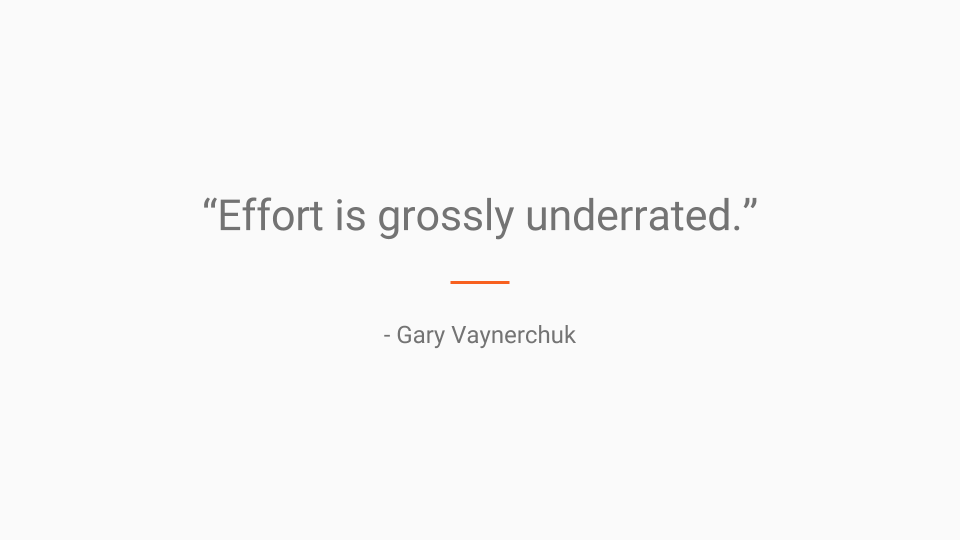
Ian: Now this is from Gary Vaynerchuk. Gary V, as we know him famously. And he says, "Effort is grossly underrated."
Craig: Well, there's a quote.
Ian: It is. Now I encourage you all to think about that. Like nothing...I know, like everything we do takes hard work. We've discussed a lot about how we grow this podcast and what we do, and even just doing that on a weekly basis has been a lot of effort, for you, for me, for people in our teams, people that support us like Chris, who does the editing. And I think that's fantastic, but I think there's a very poignant quote for us to remember.
Craig: Well, the thing about Gary is he works really hard, and I like that there's no magic formula, no silver bullet, what's another cliché or quote I can use there? But yeah, he walks the talk, there you go, add another one in there.
Ian: That's right.
Craig: He works really hard, and he's reaping the rewards of it, and that's why I'm actually really glad he's talking at INBOUND as well. Looking forward to seeing him. Yeah.
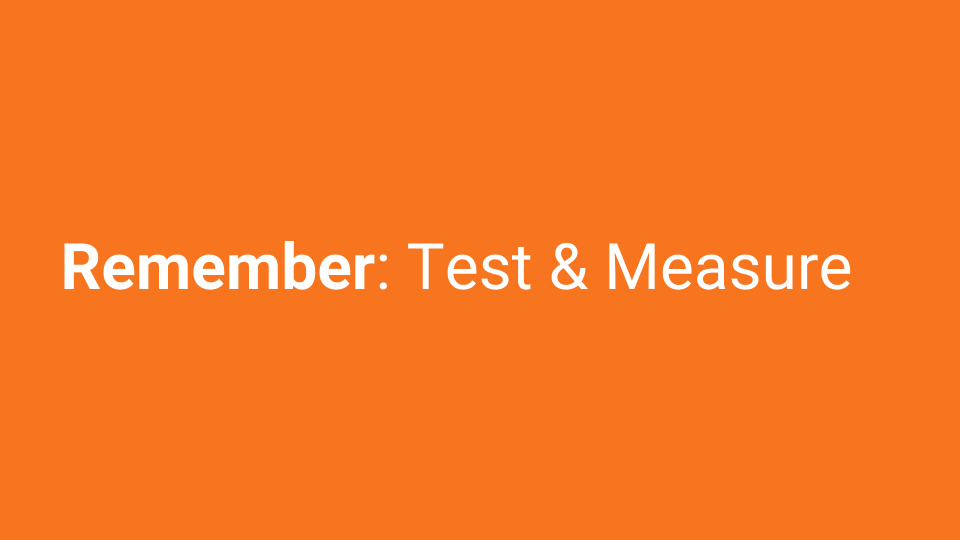
Ian: All right, and now, our final thought is always remember to test and measure because that is very important in everything that you do, because, you know, things are vying for your attention, so make sure you got the right channel, and you're testing and measuring and making sure you're getting ROI out of that channel, and you have a clear goal about what you want to achieve.
Craig: Absolutely.
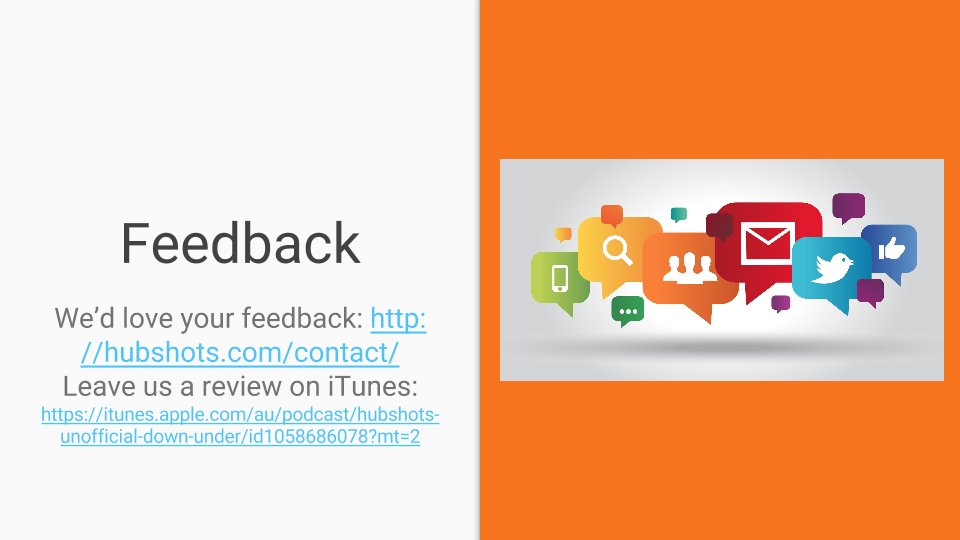
Ian: And Craig, here endeth the episode, we'd love feedback from people, so we'd love to hear feedback. Please leave us a review on iTunes. We would also love to hear any feedback you have in terms of the way the show is laid out, if you would like to hear us add anything in there, we would love to hear from you. And until next week, Craig...
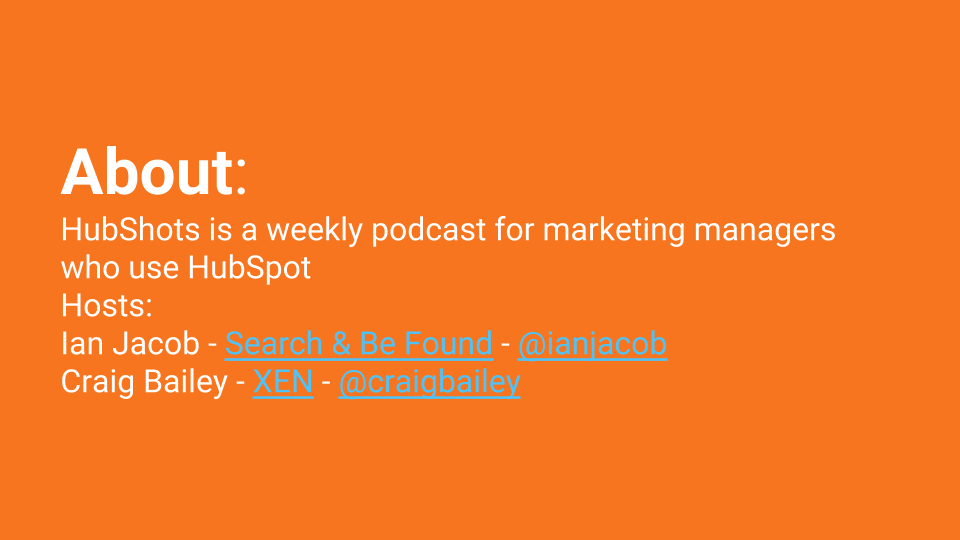
Craig: I'll see you then, Ian.
Ian: Have a great week.
Craig: Thanks, mate.

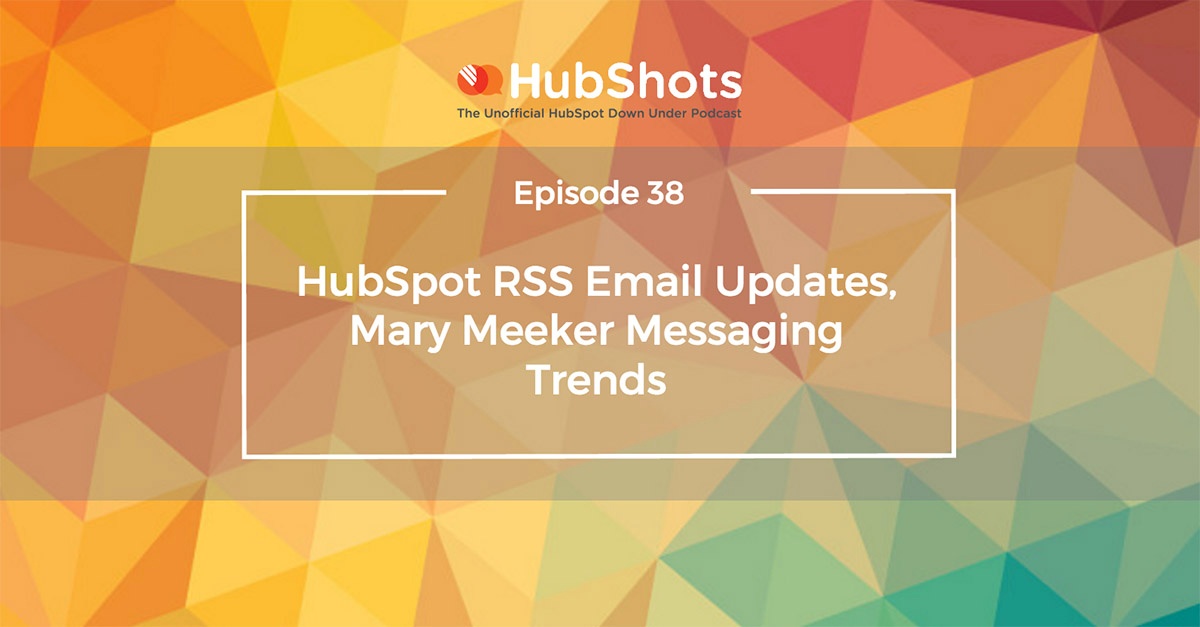
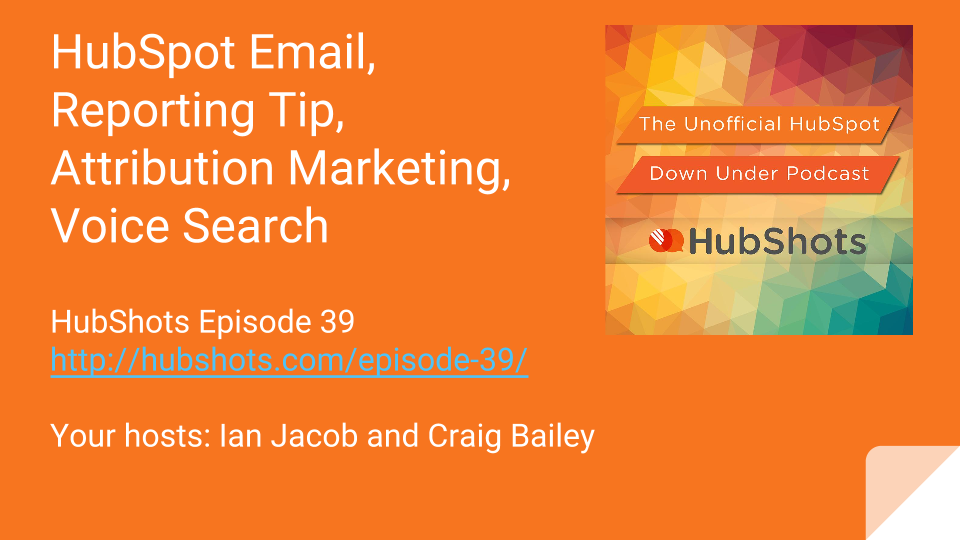
Welcome to Episode 39 of HubShots! Recorded: Tuesday 21 June 2016 This week we’re again testing adding the show notes in a range of formats including
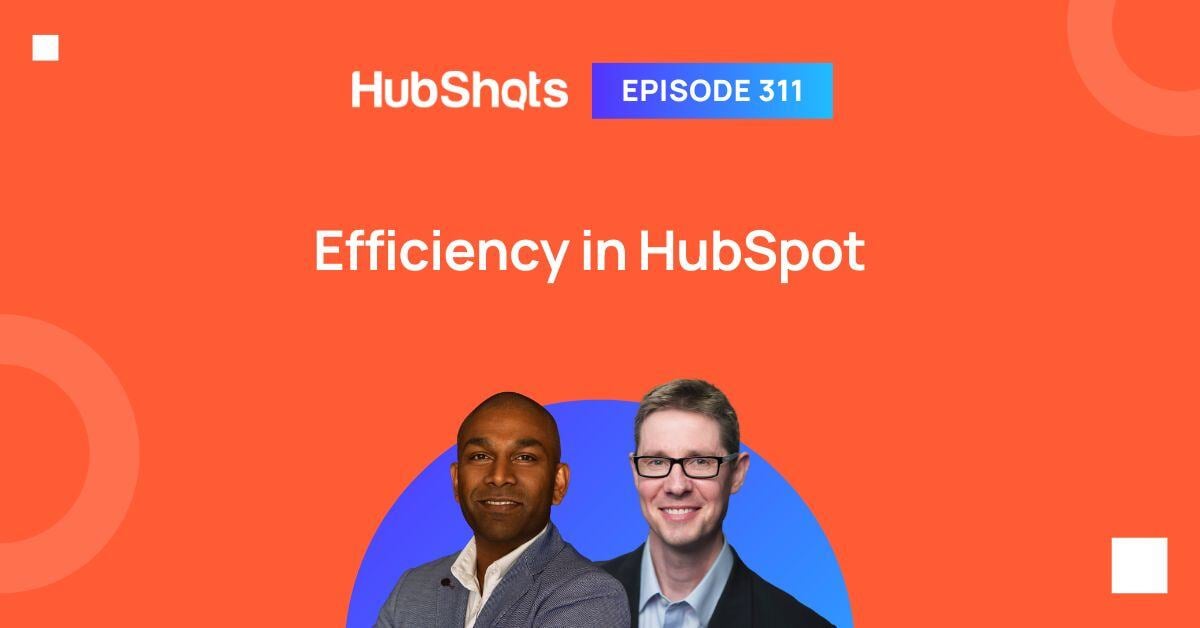
Welcome to HubShots Episode 311: Efficiency in HubSpot This edition we dive into: Deep Thoughts… Should you build your website on HubSpot ...
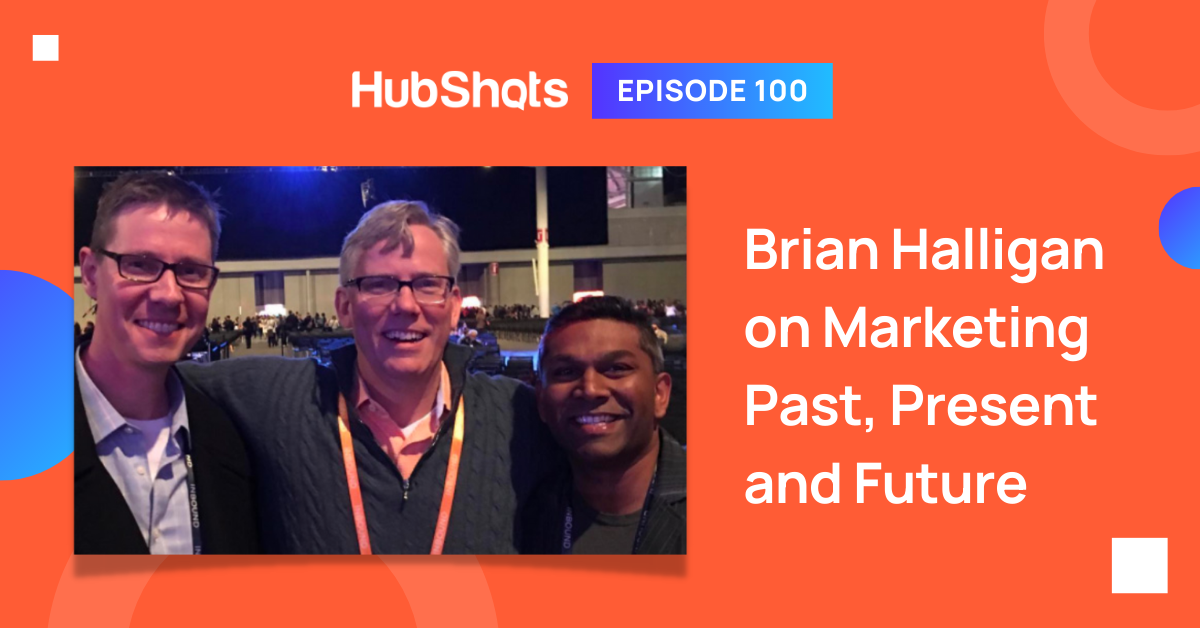
Welcome to Episode 100 of HubShots! Welcome to HubShots, the podcast for marketing managers who use HubSpot hosted by Ian Jacob from Search & Be Found
